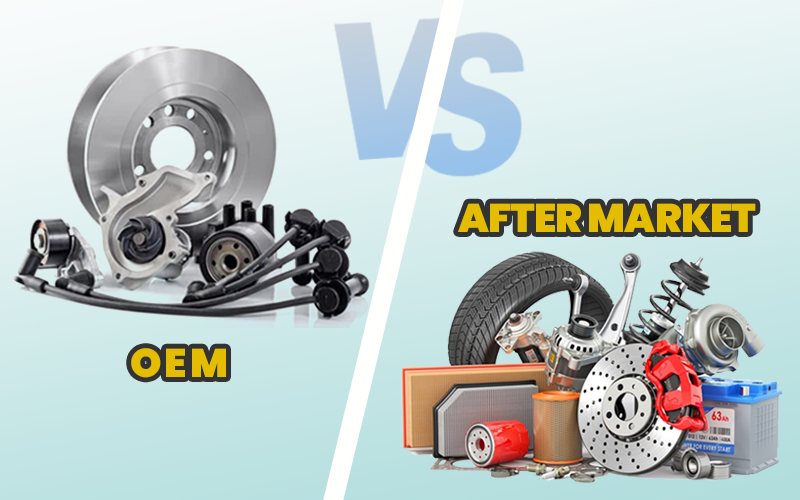
When it comes to maintaining or repairing your vehicle, one big question always pops up: Should you go with OEM parts or aftermarket parts? This decision affects not just your wallet, but also your vehicle’s performance, safety, and long-term reliability.
While some drivers swear by OEM (Original Equipment Manufacturer) parts for peace of mind, others opt for aftermarket parts for affordability and variety. Understanding the differences helps you make an informed decision and avoid costly mistakes down the road.
OEM stands for Original Equipment Manufacturer. These are the same parts your car had when it rolled off the assembly line, made either by the automaker or their authorized suppliers.
● Guaranteed Fit: Designed specifically for your vehicle model.
● Reliability:
Meets factory standards and specifications.
● Warranty Coverage :
Often comes with a manufacturer’s warranty.
● Peace of Mind :
No guesswork in compatibility.
● Higher Cost:
Typically 20–60% more expensive than aftermarket.
● Limited Availability : May require ordering from a dealership.
● Fewer Options:
No variety for performance or customization.
Aftermarket parts are produced by third-party companies not affiliated with the car’s original manufacturer. These can be direct replacements or performance upgrades.
● Lower Price : Usually cheaper than OEM alternatives.
● Wide Selection : Options for performance, style, and budget.
● Availability :
Readily found at auto shops and online retailers.
● Innovation :
Some outperform OEM in durability or performance.
● Variable Quality:
Ranges from excellent to poor.
● Fit Issues :
Some parts may not match OEM specifications exactly.
● No Standard Warranty :
Warranty terms differ widely by manufacturer.
● OEM Parts:
Consistent quality since they’re designed for your exact vehicle.
● Aftermarket Parts:
Quality depends heavily on the brand. Reputable companies may exceed OEM standards, while cheap knock-offs can fail quickly.
When buying aftermarket, research trusted brands to avoid headaches.
● OEM Parts :
Usually covered by manufacturer warranty.
● Aftermarket Parts :
Some come with limited warranties, others none.
Insurance companies often allow aftermarket parts for repairs, but OEM parts may be required for leased vehicles or under certain policies. Always check your coverage.
OEM parts often require ordering through dealerships, which may take time. Aftermarket parts are widely available at repair shops, auto retailers, and online marketplaces.
If speed matters, aftermarket is usually faster to source.
Yes many aftermarket parts are designed for enhanced performance. Examples include:
● High-performance brake pads.
● Cold air intakes.
● Heavy-duty suspension systems.
If you want more than just factory performance, aftermarket is often the better choice.
Safety should always come first. OEM parts guarantee compatibility, while aftermarket requires careful selection. Poor-quality aftermarket components can compromise safety. Stick to well-reviewed brands with proven reliability.
● OEM:
Often produced in smaller batches, sometimes shipped internationally.
● Aftermarket:
Larger production volume, wider global distribution.
Q1: Are aftermarket parts safe?
A: Yes, as long as you choose reputable brands. Cheap, low-quality parts can pose safety risks.
Q2: Do aftermarket parts void my warranty?
A: Not necessarily. Under the Magnuson-Moss Warranty Act in the U.S., a warranty can’t be voided simply for using aftermarket parts.
Q3: Why are OEM parts more expensive?
A: OEM parts come with the automaker’s branding, warranty, and guaranteed fit, which raises the cost.
Q4: Which lasts longer, OEM or aftermarket?
A: It depends. High-quality aftermarket parts can last as long—or longer—than OEM parts.
Q5: Can I mix OEM and aftermarket parts on my car?
A: Yes, many vehicles run perfectly fine with a combination of both.
When it comes to OEM vs aftermarket auto parts, there’s no one-size-fits-all answer. OEM offers peace of mind with perfect fit and reliability, while aftermarket provides affordability, availability, and customization options.
Your choice should depend on your priorities—budget, warranty, performance goals, and how much risk you’re comfortable taking. With the right knowledge, you can choose confidently and keep your vehicle running safely for years to come.